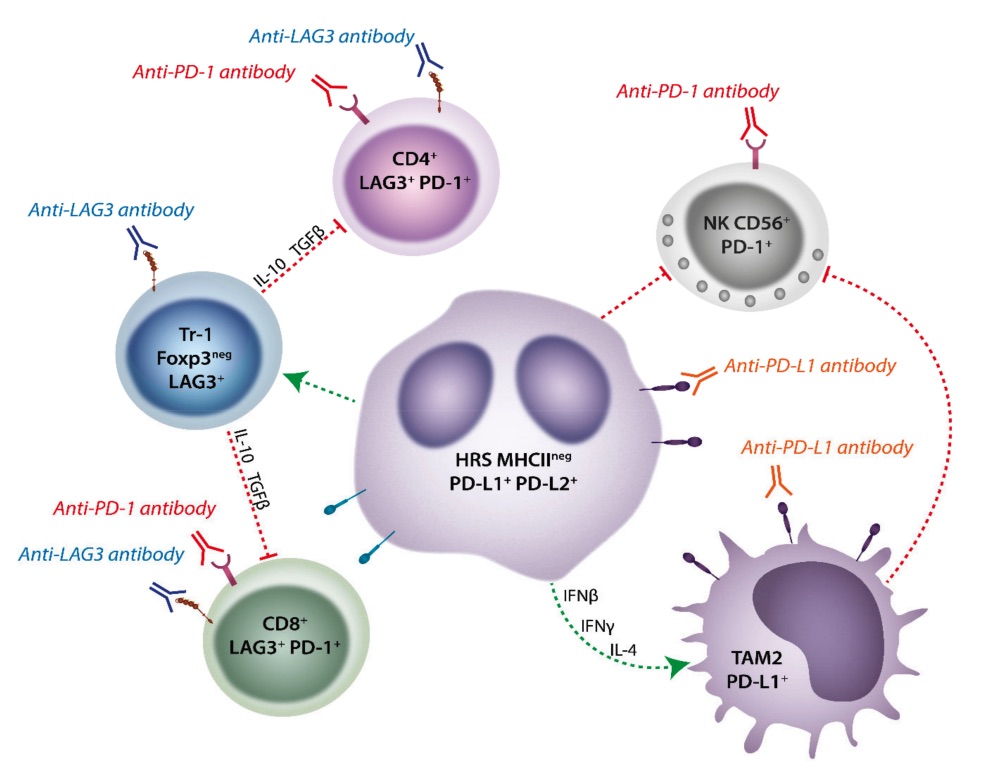Hi-Affi™ hPD-1/hPD-L1/hLAG3 Triple Humanized Mouse Model
LAG3 is a newly discovered immunosuppressive receptor. It is also called “immune brake” just like the well-known PD-1 and PD-L1. The combinational use of anti-LAG3 antibody and anti-PD-1 or anti-PD-L1 antibodies has been investigated in cancer patients and it becomes the current development trend of drugs used in clinical therapy. Creative Biolabs has successfully established an optimized Hi-Affi™ “humanized” animal platform to offer specialty manipulated hPD-1/hPD-L1/hLAG3 triple humanized mice for our clients all over the world.
hPD-1/hPD-L1/hLAG3 Molecule
Human programmed cell death protein-1 (hPD-1) exists on the cell surface in a monomeric form and is first expressed in double-negative cells in the thymus. It also presents on activated T cells, B cells, natural killer cells (NKs), dendritic cells (DCs), and activated monocytes. hPD-1 usually forms a signaling pathway with its ligands and its ligands include human programmed cell death ligand -1 (hPD-L1).
Human lymphocyte activation gene 3 (hLAG3), also called CD223, is an immune checkpoint receptor protein, mainly expressed in activated T cells, NKs, B cells, and plasma DCs. hLAG3 downregulates the activity of T cells mainly through binding to the ligand MHC class II molecules. At the same time, hLAG3 can also enhance the inhibitory activity of regulatory T cells (Tregs). The use of therapeutic antibodies to inhibit hLAG3 can release the inhibition of T cells and enhance the body's immune response.
 Fig. 1 MHC-II Deficient Classical Hodgkin Lymphoma fosters a unique tumor microenvironment that is amenable to dual LAG-3/PD-1 blockade.1
Fig. 1 MHC-II Deficient Classical Hodgkin Lymphoma fosters a unique tumor microenvironment that is amenable to dual LAG-3/PD-1 blockade.1
hPD-1/hPD-L1/hLAG3 Signal Pathway
hPD-1 and hPD-L1 have negative immunomodulatory effects. The second signal activating the T cells includes hPD-1 and hPD-L1 signaling pathway. This signaling pathway will block T cell activation and bring T cells into the resting state. Therefore, this pathway suppresses the initial and effect stages of the immune response and maintains the body's immune self-stability, otherwise the excessive immune response will lead to the occurrence of autoimmune diseases. However, tumor cells use this mechanism to escape immune attack and proliferate uncontrollably.
hLAG3 has a negatively regulatory effect on T cells: 1. hLAG3 negatively regulates the proliferation and function of CD4+ T cells: it inhibits the proliferation of Th1 cells and the secretion of related factors (IL-2, IFN -γ, and TNFs). 2. hLAG3 negatively regulates the proliferation and function of CD8+ T cells: in mice that block LAG3 or knock out the LAG3 gene, antigen-specific CD8+ T cells not only increase in number, but the toxic activity of CD8+ T cells is also enhanced. IFN-γ secretion is also significantly increased, which can prevent CD8+ T cells from forming long-term immune tolerance. 3. hLAG3 expressed on regulatory T cells (Tregs) can be combined with MHC class II molecules on membranes of DCs, which can inhibit DCs maturation through cytoplasmic signal transduction and can induce the formation of tolerant DCs, thereby inhibiting the activation and proliferation of T cells.
Development of hPD-1/hPD-L1/hLAG3 Triple Humanized Mice
hLAG3 has attracted much attention as an immunosuppressive receptor discovered after hPD-1 and hPD-L1. Anti-hLAG3 antibody combined with anti-hPD-1 and anti-hPD-L1 antibodies can be used as an alternative to the failure of the anti-hPD-1 or anti-hPD-L1 monotherapy. As a CRO company, Creative Biolabs not only provides the Hi-Affi™ “humanized” animal models, but also related analysis service. We have provided many years of CRO services to our global clients and recognized as a trustworthy CRO partner. If you are interested in these humanized mice or have any problems in the study, please feel free to contact us for further discussions.
Creative Biolabs also offers other various Humanized Mouse Models you may be interested in:
Reference
- Tobin, Joshua WD, et al. "PD-1 and LAG-3 checkpoint blockade: Potential avenues for therapy in B-cell lymphoma." Cells 10.5 (2021): 1152. Distributed under Open Access license CC BY 4.0, without modification.
For Research Use Only.
